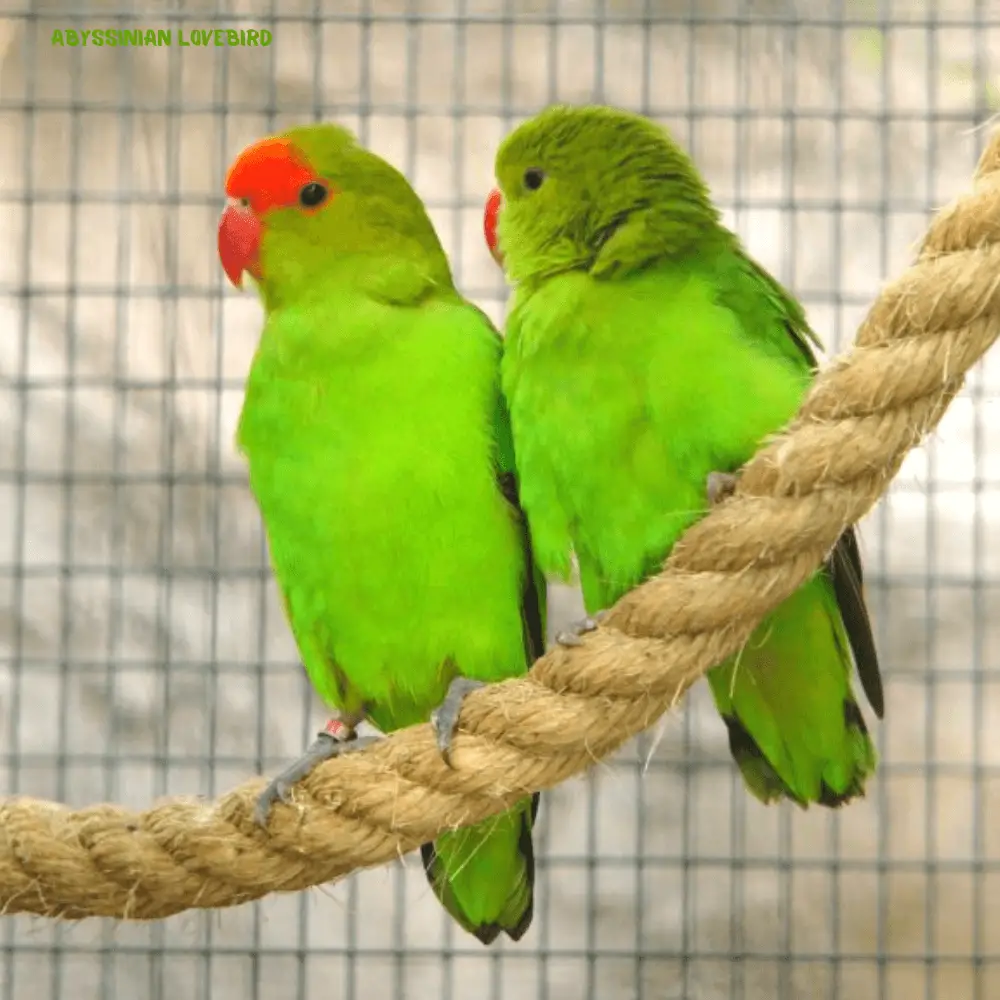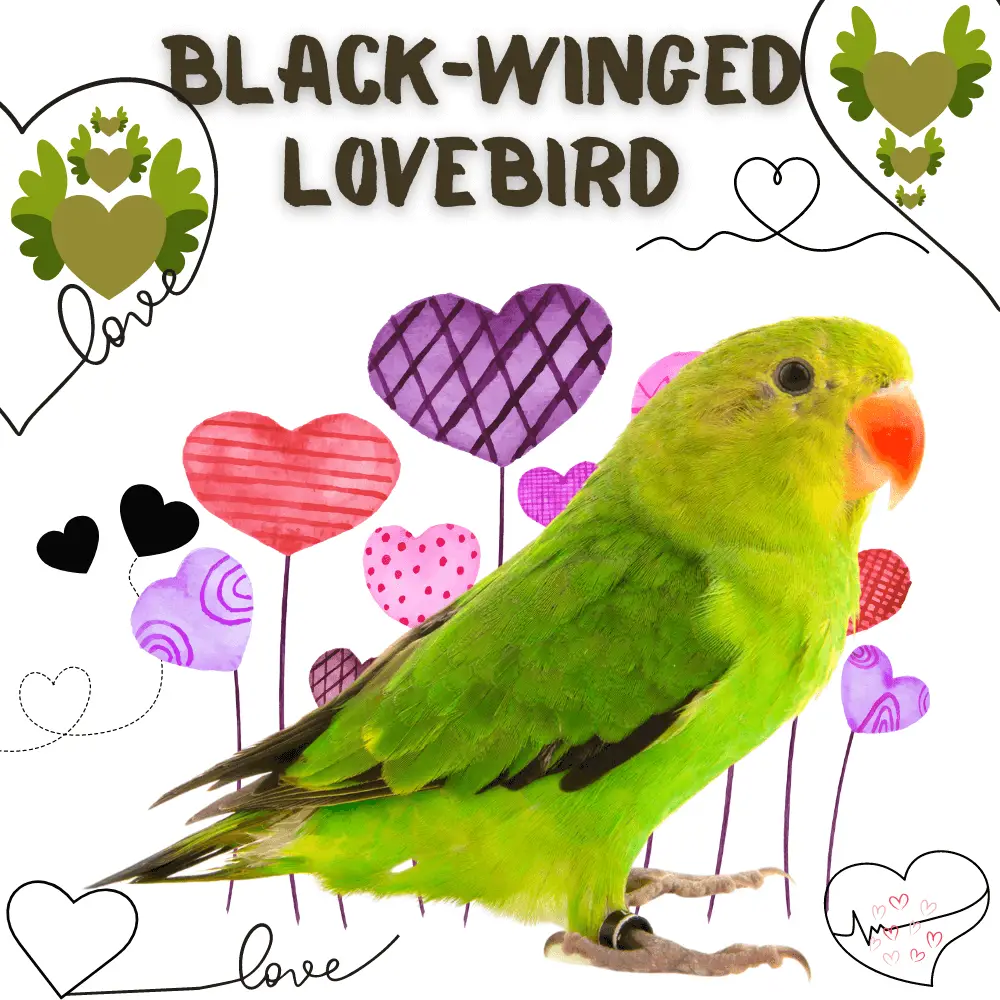Black-winged lovebird: also known as Abyssinian lovebird Among the nine species of Abyssinian Lovebird is one of the most loved and undoubtedly one of the best species that can be kept if you are thinking of having one of these birds at home.
When did the Abyssinian Lovebird appear?
Black-winged lovebird was discovered in 1814 in an area of Ethiopia, where it originated. It is one of the most resistant, as it can live up to 3,000 meters above sea level.
Although it is a species that many breeders wish they had, in reality, there is very little information about this bird and that means it is hardly imported. Some countries, like Ethiopia, where they come from, have banned their export in order to avoid the extinction of a bird that very few know how to properly care for.
Description
the Black-winged lovebird is also called a mountain parrot and belongs to the species of agapornids without white rings! Rooster: the forehead is red, the feathers of the wings and the lower part of the wings are black, and the rest of the body is green.
Hen: completely green. young animals: colored like the females, but the young lovebirds already have black lower wings! The beak is red in both sexes. The Black-winged lovebird measures approximately 17 cm wide!
Distribution

he lives in the highlands of Ethiopia at about 3200m above normal…
Lifestyle in a free nature
the mountain parrot lives mainly in forest areas. It lives in small groups of about 5 to 10 animals. The tarantula parrot feeds in the wild on juniper berries and figs! During the breeding season, the hen carries pieces of twigs and leaves in the plumage into the nesting cave!
Keeping in captivity
The mountain bird is very hardy and less sensitive to cold than other lovebird species. The females are very aggressive during the breeding season! At least as a couple (lovebirds/lovebirds). They have a pleasantly quiet voice, which also sets them apart from other lovebird species!
Captive breeding
Successful breeding depends on the harmony of the couples, which is why it is not so often successful! The hen lays 3-4 eggs in the nest box, the nesting material consists of tree bark and leaves! After 6 to 8 weeks, the young leave the nest, but are then fed for a long time by their parents! The red coloration of roosters is only visible after 100 days…
SOURCE: Lazaros Zacharia
Nutrition in captivity
Sunflower seeds, shiny seeds, oats, hemp, lots of fruits and vegetables (apple, pear……etc.)

How is the lovebird?
It is a medium-sized lovebird that measures about 17 centimeters from beak to tail and can weigh up to 75 grams. Despite being animals that live in such high areas, they possess the charm and docile and calm character of the rest of their relatives of this breed. Unlike other lovebird species, no subspecies are known.
The color of its plumage is generally a dark green tone, except for the head, flanges, and face which have a reddish tone. On the chest, abdomen, and underside of the body, the green color is somewhat paler, and the wing undercoat and rounded feathers are black.
Its beak is red, its irises are dark brown and its legs are usually gray. On contact, its feathers are quite soft, so it is very pleasant to pet this bird.
It is not so difficult to differentiate the male from the female, as it has sexual dimorphism. The difference is in the head, the flanges, and the area of the face which are green, like the underside of the wings, while in the male they are reddish. This makes it fairly easy to tell them apart, even when they are young.
In the case of the young, these birds closely resemble the females, but as the reddish color of the face and head develops, it appears gradually.
To know when they are young if it is male or female, they look at the underside of the wings, which turn black at the age of four months. In some cases, they can be distinguished when smaller as red feathers begin to appear on the forehead.
Is it difficult to reproduce?

Although today it is quite difficult to find a Black-winged lovebird It is not entirely impossible because there are many breeders who have managed to expand their breeding throughout the European continent.
At first, it is a bird that can be quite shy, but when not observed it is very active. Little by little, he gets used to human contact and it will not be very difficult to get him out of his cage.
In the case of an import from abroad, you have to be very careful, because they are birds that are very susceptible to contracting infections, which is why they must be fed vitamin C in the water. In addition, it is a bird that likes to gnaw wood, for example. so you have to give him some fruit branches to keep him entertained.
When it comes to housing this bird, the ideal is that it is in a couple, because despite its animal love, it is aggressive with other species. The route should be more or less 2x1x2 meters in the event that there will be two such birds, half if there will be only one. In the cage there should be two nesting boxes, so you can choose the one you like best and feel comfortable inside.
Food is the key to keeping this breed alive. According to expert breeders, their diet should consist of a combination of millet seeds, a mixture of canaries, sunflower seeds, and hemp. Also, it is good to add a little branch millet and sometimes herbal sprouts. In great abundance, they will need to eat fruits, greens, and vegetables to receive all the vitamins and minerals they need to survive.
Although it is not a difficult species to breed, it is more so than other breeds of lovebirds. The pair should be together in the aviary from the start so that there is a bond between them.
It is not advisable to try to combine the male with different partners, because he is a very affectionate bird with his partner and when he does not have it, he will feel sad even if there is one. another who comforts him. If this is achieved there will be three to five eggs at each laying and after 24 days the chicks will hatch.
Related article:

